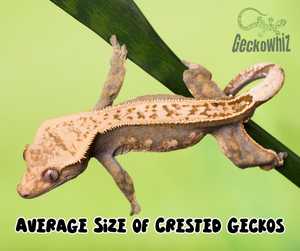The crested gecko (Correlophus ciliatus), also known as the New Caledonian gecko, is a fascinating lizard with a prehistoric look, native to the rainforests of the New Caledonia islands.
Thanks to their docile temperament and low maintenance requirements, crested geckos are highly regarded as pets. However, before deciding to adopt a crested gecko, it is important to adequately inform yourself of their needs and biological characteristics.
One of the key aspects to know is the average size of this species. Understanding the typical dimensions of crested geckos allows you to set up a terrarium of adequate size and offer the best growing conditions for your gecko.
In this article we will analyze in detail the average size of crested geckos, both in adult and young specimens. We will examine the factors that influence growth and final size of these fascinating reptiles. We will also compare their size with that of other species of lizards commonly bred as pets.
The Importance of Knowing the Average Size of a Crested Gecko
To properly care for a crested gecko, it is essential to understand what its typical size is once fully grown. This information is important for several reasons:
- It allows you to choose a terrarium of suitable size, large enough to allow the gecko’s movements but not excessively big.
- It allows you to provide furnishings and accessories of appropriate size inside the terrarium.
- It helps establish the required food amount and equip accordingly.
- It allows you to monitor the gecko’s growth and development by comparing its size over time.
- It allows you to assess if the gecko has health or developmental issues based on its size.
In general, knowing the average size allows you to provide the best management and care conditions for your crested gecko.
Factors Influencing Crested Gecko Size
The final size a crested gecko can reach depends on several factors:
- Sex: Males are slightly larger than females, with a length of about 20-28 cm compared to 15-20 cm for females.
- Diet: A balanced and complete diet is essential for healthy growth.
- Health: Diseases or health issues can hinder proper growth.
- Genetics: Genetic predisposition may influence final size to some extent.
- Breeding conditions: A suitable habitat, with optimal temperature and humidity, promotes normal growth.
- Age: As the years go by even after maturity, geckos may slightly increase in size.
The Average Size of Crested Geckos

On average, the total length of an adult crested gecko ranges from 15 to 28 cm measured from the tip of the snout to the tip of the tail.
Specifically:
- Males typically reach 20-28 cm in length.
- Females are slightly smaller, with an average length of 15-20 cm.
- The tail constitutes about half of the total length.
- The average weight is around 40-65 g.
Hatchlings are about 3-4 cm long and weigh 1-2 g at birth. Growth is quite rapid in the first months of life.
Comparison with Other Reptiles
Compared to other commonly bred lizard species, the crested gecko has a small-medium size:
- It is larger than the leopard gecko (15-20 cm)
- It is comparable with the Tokay gecko (15-30 cm)
- It is smaller than the giant day gecko (30-40 cm)
- It is much smaller than an iguana (1-2 m) or python (2-3 m)
The medium-small size makes it ideal for being bred in terrariums of reduced dimensions compared to other reptiles.
Growth and Development of Crested Geckos
The growth of crested geckos can be divided into the following stages:
- Newborns: 3-4 cm long at birth. Grow rapidly.
- Juveniles: reach about half their final length at 6-8 months of age.
- Subadults: between 8 months and 1 year they reach almost adult size but not yet sexually mature.
- Adults: after about 1 year, reach sexual maturity and final size. Growth slows down.
- Elderly: after 5-6 years, growth stops and size stabilizes.
Tips for Measuring Crested Gecko Size
To monitor your crested gecko’s growth, you will need to measure it regularly. Here are some tips to take measurements accurately and safely:
- Always use a ruler or flexible tape measure. Position it near the gecko, not above to avoid scaring it.
- Measure the gecko from the tip of the snout to the tip of the tail to obtain total length.
- You can also measure just the body, excluding the tail.
- Take measurements at approximately the same time, when the gecko is active.
- Gently grasp the gecko or let it climb onto a branch or your hand.
- Record the measurements to track growth. Compare the data over time.
- Periodically weighing the gecko helps monitor its health and development.
Conclusion
Knowing the average size of crested geckos is important in order to offer them the best management and breeding conditions. Adult males typically reach 20-28 cm in length, while females are slightly smaller, at 15-20 cm.
Final size depends on various factors such as sex, diet, health and genetics. By comparing your gecko’s growth with the typical size of the species you can assess its condition. By providing it with a proper diet and suitable habitat, healthy growth will be encouraged allowing it to reach its maximum physical potential.
